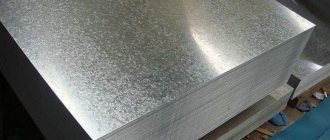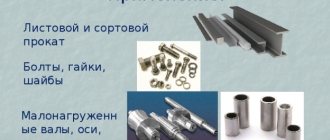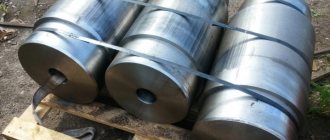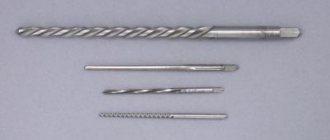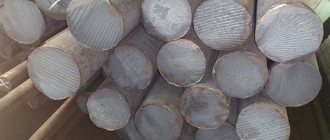To change the basic performance properties of metals, an alloying process is quite often carried out. It involves the inclusion of additional chemical elements in the basic composition of the metal that can change certain properties. The alloying process is so widespread that most modern metals belong to this group. An example is 20x steel. It is a representative of the group of structural steels, but chromium was added to the composition to change some of the performance properties of the metal. Let's take a closer look at 20x steel, its characteristics, application and many other qualities.
Decoding the brand
Deciphering the markings of structural steels is quite simple. The metal in question has the following composition:
- Carbon content ranges from 0.17 to 0.23%. This element determines the hardness and brittleness of the metal.
- Alloying in this case is carried out by adding chromium to the composition. The fact that there is no number after the letter designating the element indicates the concentration of chromium in the composition is no more than one percent.
- There are also other elements characteristic of structural steels.
Alloying of the metal in question is carried out in order to increase the hardness of the surface layer, leaving the core less strong and more flexible.
20X
- 20X steel products available:
Circle - Sheet
- Band
- Square
- Hexagon
- Forging
to make a request
Steel 20X structural alloy chromium
Substitutes: Steel 18ХГТ, Steel 20ХН, Steel 12ХН2, Steel 15Х
Steel 20X is used: for the production of hot-rolled plates; bushings, gears, cages, sleeves, disks, plungers, levers and other cemented parts, which are subject to the requirement of high surface hardness with low core strength; parts operating under conditions of wear and friction; parts of pipeline fittings made of rolled steel; stamped blanks and forgings (heat treatment required: quenching in water and tempering in air).
Specifications
| Chemical composition in% |
| NTD | C | S | P | Mn | Cr | W | V | Ti | Si | Ni | Mo | Cu |
| TU 14-1-3238-81 | 0,17-0,23 | ≤0,030 | ≤0,030 | 0,50-0,80 | 0,70-1,00 | ≤0,20 | ≤0,050 | ≤0,030 | 0,17-0,37 | ≤0,30 | ≤0,15 | ≤0,30 |
| GOST 10702-78 | 0,17-0,23 | ≤0,035 | ≤0,035 | ≤0,60 | 0,70-1,00 | ≤0,20 | ≤0,050 | ≤0,030 | ≤0,20 | ≤0,30 | ≤0,15 | ≤0,30 |
| TU 14-1-4118-86, GOST 4543-71 | 0,17-0,23 | ≤0,035 | ≤0,035 | 0,50-0,80 | 0,70-1,00 | ≤0,20 | ≤0,050 | ≤0,030 | 0,17-0,37 | ≤0,30 | ≤0,15 | ≤0,30 |
According to GOST 4543-71, the content in high-quality steel is regulated: P≤0.025%; S≤0.025%; Сu≤0.30%; in especially high-quality steel: P≤0.025%; S≤0.015%; Сu≤0.25%. In accordance with the order, the content of Si=0.10-0.37%, Mn=0.4-0.8% can be set. According to TU 14-1-3238-81, the chemical composition is given for steel grade 20ХА. For steel grade 20ХА-СШ the content is S≤0.015%.
| Mechanical properties |
| Mechanical properties at 20°C |
| Delivery status | Section (mm) | t test (°C) | holiday temperature (°C) | sТ | s0.2 (MPa) | sB (MPa) | d5 (%) | d4 | d | d10 | y (%) | KCU (kJ/m2) | HB | H.R.C. | HRB | H.V. | HSh |
| Blanks for pipeline fittings. Quenching in water from 880-900 °C (holding time 2.5-4.0 hours, depending on the thickness and weight of the workpiece) + Tempering, air cooling | ||||||||||||||||
| max 80 | 500-560 | ≥345 | ≥590 | ≥16 | ≥45 | ≥588 | 174-217 | |||||||||
| Sections (bars). Quenching in water or oil from 880 °C + Quenching in water or oil from 770-820 °C + Tempering at 180 °C, cooling in air or oil | ||||||||||||||||
| ≤15 | ≥635 | ≥780 | ≥11 | ≥40 | ≥579 | |||||||||||
| Sections (bars). Carburization at 920-950 °C, air cooling + Oil quenching from 800 °C + Tempering at 190 °C, air cooling | ||||||||||||||||
| 40-60 | ≥390 | ≥640 | ≥13 | ≥40 | ≥481 | ≥250 | 55-63 | |||||||||
| Seamless hot-deformed pipes as delivered | ||||||||||||||||
| Sample | ≥431 | ≥16 | ||||||||||||||
| Seamless cold-deformed pipes in the delivered condition, heat-treated (НВ - for wall > 10 mm) | ||||||||||||||||
| Sample | ≥431 | ≥17 | ≤179 | |||||||||||||
| Mechanical properties of the rod |
| Delivery status | Section (mm) | t test (°C) | holiday temperature (°C) | sТ | s0.2 (MPa) | sB (MPa) | d5 (%) | d4 | d | d10 | y (%) | KCU (kJ/m2) | HB | H.R.C. | HRB | H.V. | HSh |
| Hot-rolled and hot-rolled steel with special surface finishing, heat-treated | ||||||||||||||||
| Sample | ≤163 | |||||||||||||||
| Calibrated and calibrated steel with special surface finish | ||||||||||||||||
| Hard-worked (without t/o) | ≥590 | ≥5 | ≥45 | ≤207 | ||||||||||||
| After annealing (vacation) | ≤550 | ≥60 | ≤179 | |||||||||||||
| After spheroidizing annealing | 360-470 | ≥60 | ≤179 | |||||||||||||
| Mechanical properties of forgings |
| Delivery status | Section (mm) | t test (°C) | holiday temperature (°C) | sТ | s0.2 (MPa) | sB (MPa) | d5 (%) | d4 | d | d10 | y (%) | KCU (kJ/m2) | HB | H.R.C. | HRB | H.V. | HSh |
| Forgings. Quenching + Tempering | ||||||||||||||||
| KP 245 | 100-300 | ≥245 | ≥470 | ≥19 | ≥42 | ≥383 | 143-179 | |||||||||
| KP 275 | 100-300 | ≥275 | ≥530 | ≥17 | ≥38 | ≥333 | 156-197 | |||||||||
| KP 275 | <100 | ≥275 | ≥530 | ≥20 | ≥40 | ≥432 | 156-197 | |||||||||
| KP 315 | 100-300 | ≥315 | ≥570 | ≥14 | ≥35 | ≥333 | 167-207 | |||||||||
| KP 345 | 100-300 | ≥345 | ≥590 | ≥17 | ≥40 | ≥530 | 174-217 | |||||||||
| Forgings. Normalization | ||||||||||||||||
| KP 195 | 100-300 | ≥195 | ≥390 | ≥23 | ≥50 | ≥530 | 111-156 | |||||||||
| KP 195 | 300-500 | ≥195 | ≥390 | ≥20 | ≥45 | ≥481 | 111-156 | |||||||||
| KP 195 | <100 | ≥195 | ≥390 | ≥26 | ≥55 | ≥579 | 111-156 | |||||||||
| KP 215 | 100-300 | ≥215 | ≥430 | ≥20 | ≥48 | ≥481 | 123-167 | |||||||||
| KP 215 | <100 | ≥215 | ≥430 | ≥24 | ≥53 | ≥530 | 123-167 | |||||||||
| KP 245 | <100 | ≥245 | ≥470 | ≥22 | ≥48 | ≥481 | 143-179 | |||||||||
| Mechanical properties depending on tempering temperature |
| Delivery status | Section (mm) | t test (°C) | holiday temperature (°C) | sТ | s0.2 (MPa) | sB (MPa) | d5 (%) | d4 | d | d10 | y (%) | KCU (kJ/m2) | HB | H.R.C. | HRB | H.V. | HSh |
| Rod with a diameter of 25 mm. Quenching in oil from 900 °C + Tempering | ||||||||||||||||
| 200 | ≥650 | ≥880 | ≥18 | ≥58 | ||||||||||||
| 300 | ≥690 | ≥880 | ≥16 | ≥65 | ||||||||||||
| 400 | ≥690 | ≥850 | ≥18 | ≥70 | ||||||||||||
| 500 | ≥670 | ≥780 | ≥20 | ≥71 | ||||||||||||
| 600 | ≥610 | ≥730 | ≥20 | ≥70 | ||||||||||||
| Mechanical properties at elevated temperatures |
| Delivery status | Section (mm) | t test (°C) | holiday temperature (°C) | sТ | s0.2 (MPa) | sB (MPa) | d5 (%) | d4 | d | d10 | y (%) | KCU (kJ/m2) | HB | H.R.C. | HRB | H.V. | HSh |
| A sample with a diameter of 6 mm and a length of 30 mm is forged and normalized. Deformation speed 16 mm/min. Strain rate 0.009 1/s | ||||||||||||||||
| 700 | ≥120 | ≥150 | ≥48 | ≥89 | ||||||||||||
| 800 | ≥63 | ≥93 | ≥56 | ≥74 | ||||||||||||
| 900 | ≥51 | ≥84 | ≥64 | ≥88 | ||||||||||||
| 1000 | ≥33 | ≥51 | ≥78 | ≥97 | ||||||||||||
| 1100 | ≥21 | ≥33 | ≥98 | ≥100 | ||||||||||||
| 1200 | ≥14 | ≥25 | ||||||||||||||
| Technological properties |
| Weldability | Weldable without restrictions (except for chemically and thermally treated parts). Welding methods: RDS, KTS. |
| Tendency to temper brittleness | Not inclined. |
| Forging temperature | Start - 1260 °C, end - 760 °C. Workpieces with a cross-section of up to 200 mm are cooled in air, while 201-700 mm are subjected to low-temperature annealing. |
| Flock sensitivity | Insensitive. |
| Critical point temperature |
| Critical point | Temperature °C |
| AC1 | 750 |
| AC3 | 825 |
| AR3 | 755 |
| AR1 | 665 |
| MN | 390 |
| Impact strength |
| Delivery condition temperature | +20 | -20 | -40 | -60 |
| Rod with a diameter of 115 mm. Hardening. Vacation. | 280-286 | 280-289 | 277-287 | 261-274 |
| Endurance limit |
| Heat treatment, steel condition | s-1 (MPa) | t-1 (MPa) | n | sB (MPa) | s0.2 (MPa) |
| Normalization. HB 143-179 | 235 | 1E+7 | 450-590 | 295-395 | |
| Hardening. High holiday. HB 217-235 | 295 | 1E+7 | 690 | 490 | |
| Cementation. Hardening. Low vacation. HRCе 57-63 | 412 | 1E+7 | 930 | 790 |
| Hardenability |
Hardening 860 °C.
Hardness for hardenability strips HRCе. Distance from the end, mm/HRCе
| 1.5 | 3 | 4.5 | 6 | 7.5 | 9 | 10.5 | 13.5 | 18 |
| 38,5-49 | 34-46,5 | 29-44 | 24,5-40 | 22-35,5 | 32,5 | 30 | 27 | 24,5 |
| Heat treatment | Amount of martensite, % | Crete. dia. in water | Crete. dia. In oil | Crete. hardness, HRCе | Dist. from the cooled end, mm |
| 50 | 26-48 | 8-24 | 32-36 | ||
| 90 | 12-28 | 3-9 | 38-42 |
| Physical properties |
| Test temperature, °C | 0 | 20 | 100 | 200 | 300 | 400 | 500 | 600 | 700 | 800 | 1000 |
| Modulus of normal elasticity (E, GPa) | 216 | 216 | 213 | 198 | 193 | 181 | 171 | 165 | 143 | 133 | |
| Modulus of elasticity under torsional shear (G, GPa) | 84 | 83 | 76 | 74 | 71 | 67 | 62 | 55 | 50 | ||
| Density (r, kg/m3) | 7830 | 7830 | 7810 | 7780 | 7710 | 7640 | |||||
| Thermal conductivity coefficient (l, W/(m °C)) | 42 | 42 | 42 | 41 | 40 | 38 | 36 | 33 | 32 | 31 | |
| Ud. electrical resistance (R, NΩ m) | |||||||||||
| Linear expansion coefficient (a, 10-6 1/°С) | 10,5 | 11,6 | 12,4 | 13,1 | 13,6 | 13,6 | 14 | ||||
| Specific heat capacity (C, J/(kg °C)) | 496 | 508 | 525 | 537 | 567 | 588 | 626 | 626 | 706 |
| Designations |
Mechanical properties:
|
Basic properties
The distribution of the metal in question is due to the fact that it has a relatively low cost and is suitable for the manufacture of a wide variety of parts . The main properties include the following information:
- Normalization is often carried out as a heat treatment. It makes the material more resistant to mechanical stress.
- The specific gravity is 7830 kilograms per cubic meter.
- The surface hardness is relatively low, but often this is quite enough for the manufacture of various non-critical parts.
- It is possible to carry out cutting processing, for which the metal is preheated.
- By adding chromium to the composition, the degree of weldability is significantly increased. An exception is the case when it is necessary to weld parts that have previously undergone a chemical-thermal treatment process.
- No tendency to temper brittleness.
In addition, do not forget that the presence of a small amount of chromium in the composition does not lead to increased corrosion resistance. Therefore, steel is not suitable for the manufacture of parts that will be used in an aggressive environment.
Steel 20X - structural alloy
Substitutes
Steels 15Х, 20ХН, 12ХН2, 18ХГТ.
Foreign analogues
| Germany DIN | 20Cr4, 20CrS4 | |
| USA (AISI, SAE, ASTM) | 5120, 5120H | |
| UK (BS) | 207 | |
| Japan (JIS) | SCr420, SCr420H | |
IMPORTANT!!! The possibility of replacement is determined in each specific case after assessing and comparing the properties of steels
Type of delivery
Long products, including shaped steel: GOST 4543-71, GOST 2590-88, GOST 2591-88, GOST 10702-78, GOST 2879-88.
Calibrated rod GOST 8559-75, GOST 8560-78, GOST 7417-75, GOST 1051-73.
Polished rod and silver GOST 14955-77.
Thick sheet GOST 1577-93, GOST 19903-74.
Strip GOST 82-70, GOST 103-76.
Forgings and forged blanks GOST 1133-71, GOST 8479-70.
Pipes GOST 8731-87, GOST 8732-78, GOST 8733-74, GOST 8734-75, GOST 13663-86.
Purpose
Bushings, gears, cages, sleeves, disks, plungers, levers and other cemented parts, which are subject to the requirements of high surface hardness with low core strength, parts operating under friction wear conditions.
Decoding steel 20X
The number 20 means that the carbon content of the steel is 0.2%.
The letter X means that the steel contains chromium in amounts up to 1.5%.
Application of 20X steel bodies, covers, flanges, membranes and valve assembly made from rolled products, forgings (stampings) (GOST 33260-2015)
| steel grade | ND for supply | Temperature of the working medium (wall), °C | Additional instructions for use |
| 20X GOST 4543 | Forgings GOST 8479. Long products GOST 4543. Sheets GOST 1577, categories 2, 3. Pipes GOST 8731 gr.V, GOST 8733 gr.V | -40 to 450 | For welded reinforcement assemblies operating in non-aggressive environments |
The use of 20X steel for parts of valves and pneumatic actuators that do not operate under pressure and are not subject to welding, intended for operation at low temperatures (GOST 33260-2015)
| steel grade | Quenching + tempering at temperature, °C | Approximate strength level, N/mm2 (kgf/mm2) | Application temperature not lower, °C | Use in thickness no more than, mm |
| 20X | 200 | 900 (90) | -60 | 15 |
NOTE
- When heat treated for strength below that specified in column 3 or when used in parts with a wall thickness of less than 10 mm, the operating temperature may be reduced.
- The maximum thickness indicated in column 5 is due to the need to obtain through hardenability and uniformity of properties across the cross section.
Temperature of critical points, °C
| Ac1 | Ac3 | Ar3 | Ar1 | Mn |
| 750 | 825 | 755 | 665 | 390 |
Chemical composition, % (GOST 4543-71)
| WITH | Si | Mn | Cr | Ni | Cu | S | P |
| no more | |||||||
| 0,17-0,23 | 0,17-0,37 | 0,5-0,8 | 0,7-1,0 | 0,30 | 0,30 | 0,035 | 0,035 |
Chemical composition, % (GOST 4543-2016)
| steel grade | Mass fraction of elements, % | |||||||||
| WITH | Si | Mn | Cr | Ni | Mo | Al | Ti | V | B | |
| 20X | 0,17-0,23 | 0,17-0,37 | 0,5-0,8 | 0,7-1,0 | — | — | — | — | — | — |
NOTE: the sign “-” means that the mass fraction of this element is not standardized or controlled unless otherwise indicated.
Hardness (GOST 4543-2016)
- The Brinell hardness of metal products in the annealed (HT) or high-tempered (HT) state, as well as hot-rolled and forged metal products, normalized with subsequent high tempering (H + HT), with a diameter or thickness of over 5 mm must comply with the standards specified in the table
steel grade Hardness HB, no more 20X 179 NOTE The hardness of calibrated metal products in the annealed (HT) or high-tempered (HT) state, as well as hot-rolled and forged metal products, normalized with subsequent high tempering (H+HT), can be 15 HB more than indicated in the table above.
- The hardness of hot-rolled and forged metal products supplied without heat treatment is not standardized or controlled.
- The hardness of calibrated metal products and metal products with special surface finishing with a diameter or thickness of over 5 mm, supplied in a cold-worked state (NG), must comply with the standards specified in the table below.
steel grade Hardness NV, no more 20X 229
Mechanical properties of rolled products (GOST 4543-2016)
| steel grade | Heat treatment mode | Mechanical properties, no less | Sectional size of workpieces for heat treatment (circle diameter or square side), mm | ||||||||
| Hardening | Vacation | Yield strength σt, N/mm2 | Tensile strength σв, N/mm2 | Relative | Impact strength KS U, J/cm2 | ||||||
| Temperature, °C | Cooling medium | Temperature, °C | Cooling medium | elongation δ5,% | narrowing Ψ, % | ||||||
| 1st hardening or normalization | 2nd hardening | ||||||||||
| 20X | 880 | 770— 820 | Water or oil | 180 | Air or oil | 635 | 780 | 11 | 40 | 59 | 15 |
Mechanical properties of rolled products
| GOST | Delivery condition, heat treatment mode | Section, mm | σ0.2, MPa | σв, MPa | δ5, % | Ψ, % | KCU, J/cm2 | Hardness, no more |
| no more | ||||||||
| GOST 4543-71 | Bar. Quenching from 880 °C in water or oil, quenching from 770-820 °C in water or oil; holiday at 180 °C, cool. in water or oil | 15 | 640 | 780 | 11 | 40 | 59 | — |
| GOST 10702-78 | Cold-worked steel - calibrated and calibrated with special finishing without heat treatment | — | — | 590 | 5 | 45 | — | HB 207 |
| Bar. Cementation at 920-950 °C, cooling. on air; hardening at 800 °C in oil; holiday at 190 °C, cool. on air | 60 | 390 | 640 | 13 | 40 | 49 | HB 250; HRC 5 55-63 | |
Mechanical properties of forgings (GOST 8479-70)
| Heat treatment | Section, mm | KP | σ0.2, MPa | σв, MPa | δ5, % | Ψ, % | KCU, J/cm2 | Hardness HB , no more |
| no less | ||||||||
| Normalization | Up to 100 | 195 | 195 | 390 | 26 | 55 | 59 | 111-156 |
| 100-300 | 23 | 50 | 54 | |||||
| 300-500 | 20 | 45 | 49 | |||||
| Up to 100 | 215 | 215 | 430 | 24 | 53 | 54 | 123-167 | |
| 100-300 | 20 | 48 | 49 | |||||
| Up to 100 | 245 | 245 | 470 | 22 | 48 | 49 | 143-179 | |
| Quenching+tempering | 100-300 | 19 | 42 | 39 | 143-179 | |||
| Up to 100 | 275 | 275 | 530 | 20 | 40 | 44 | 156-197 | |
| 100-300 | 275 | 275 | 530 | 17 | 38 | 34 | 156-197 | |
| 100-300 | 315 | 315 | 570 | 14 | 35 | 34 | 167-207 | |
| 100-300 | 345 | 345 | 590 | 17 | 40 | 54 | 174-217 | |
Mechanical properties depending on tempering temperature
| totp. °C | σ0.2, MPa | σв, MPa | δ5, % | Ψ, % | KCU, J/cm2 |
| 200 | 650 | 880 | 18 | 58 | 118 |
| 300 | 690 | 880 | 16 | 65 | 147 |
| 400 | 690 | 850 | 18 | 70 | 176 |
| 500 | 670 | 780 | 20 | 71 | 196 |
| 600 | 610 | 730 | 20 | 70 | 225 |
Note: Rod with a diameter of 25 mm; hardening at 900 °C, in oil.
Mechanical properties at elevated temperatures
| tsp. °C | σ0.2, MPa | σв, MPa | δ5, % | Ψ, % |
| 700 | 120 | 150 | 48 | 89 |
| 800 | 63 | 93 | 56 | 74 |
| 900 | 51 | 84 | 64 | 88 |
| 1000 | 33 | 51 | 78 | 97 |
| 1100 | 21 | 33 | 98 | 100 |
| 1200 | 14 | 25 | — | — |
NOTE: Sample 6mm diameter, 30mm long, forged and normalized; deformation speed 16 mm/min; strain rate 0.009 1/s.
Endurance limit at n = 107
| Heat treatment | σ-1, MPa |
| Normalization, σ0.2 = 295-395 MPa, σв = 450-590 MPa, HB 143-179 | 235 |
| Hardening + high tempering, σ0.2 = 490 MPa, σв = 690 MPa, HB 217-235 | 295 |
| Cementation + hardening + low tempering, σ0.2 = 790 MPa, σв = 930 MPa, HRCе 57-63 | 412 |
Impact strength KCU
| Delivery status | KCU , J/cm2, at temperature, °C | |||
| +20 | -20 | -40 | -60 | |
| Rod with a diameter of 115 mm; hardening + tempering | 280-286 | 280-289 | 277-287 | 261-274 |
Technological properties
Forging temperature, °C: start 1260, end 750. Workpieces with a cross-section of up to 200 mm are cooled in air, with a cross-section of 201-700 mm subjected to low-temperature annealing.
Cutting ability - K
v tv.spl = 1.3 and
K
v b.st = 1.7 in the hot-rolled state at HB 131 σw = 460 MPa.
Flock sensitivity is insensitive.
Tendency to temper brittleness - not prone.
Weldability
Steel 20X can be welded without restrictions (except for chemical-thermal treated parts). Welding methods: RDS, KTS without restrictions.
Critical diameter d
| Critical hardness HRC3 | Amount of martensite, % | d, mm, after hardening | |
| in water | In oil | ||
| 32-36 | 50 | 26-48 | 8-24 |
| 38-42 | 90 | 12-28 | 3-9 |
Physical properties
Density ρ kg/cm3 at test temperature, °C
| Steel | 20 | 100 | 200 | 300 | 400 | 500 | 600 | 700 | 800 | 900 |
| 20X | 7830 | 7810 | 7780 | — | 7710 | — | 7640 | — | — | — |
Thermal conductivity coefficient λ W/(m*K) at test temperature, °C
| Steel | 20 | 100 | 200 | 300 | 400 | 500 | 600 | 700 | 800 | 900 |
| 20X | 42 | 42 | 41 | 40 | 38 | 36 | 33 | 32 | 31 | — |
Linear expansion coefficient α*106, K-1, at test temperature, °C
| 20-100 | 20-200 | 20-300 | 20-400 | 20-500 | 20-600 | 20-700 | 20-800 | 20-900 | 20-1000 |
| 10,5 | 11,6 | 12,4 | 13,1 | 13,6 | 14,0 | — | — | — | — |
Specific heat capacity c, J/(kg*K), at test temperature, °C
| 20-100 | 20-200 | 20-300 | 20-400 | 20-500 | 20-600 | 20-700 | 20-800 | 20-900 | 20-1000 |
| 496 | 508 | 525 | 537 | 567 | 588 | 626 | 706 | — | — |
Modulus of normal elasticity E, GPa, at test temperature, °C
| Steel | 20 | 100 | 200 | 300 | 400 | 500 | 600 | 700 | 800 | 900 |
| 20X | 216 | 213 | 198 | 193 | 181 | 171 | 165 | 143 | 133 | — |
Modulus of elasticity in torsional shear G, GPa, at test temperature °C
| Steel | 20 | 100 | 200 | 300 | 400 | 500 | 600 | 700 | 800 | 900 |
| 20X | 84 | 83 | 76 | 74 | 71 | 67 | 62 | 55 | 50 | — |
Find out more
Steel 09Х15Н8У1 (09Х15Н8У, EI904) austenitic-marten...
Structural alloy steel 36Kh2N2MFA…
Steel 8X3 tool die…
Structural alloy steel 10G2…
Brand: steel, metal 20Х
Brand: 20X
| Brand: | 20X |
| Substitute: | 15Х, 20ХН, 12ХН2, 18ХГТ |
| Classification: | Alloy structural steel |
| Addition: | Chrome steel |
| Application: | Bushings, gears, cages, sleeves, disks, plungers, levers and other cemented parts, which are subject to the requirements of high surface hardness with low core strength, parts operating under friction wear conditions. |
| Foreign analogues: |
| C | Si | Mn | Ni | S | P | Cr | Cu |
| 0.17 — 0.23 | 0.17 — 0.37 | 0.5 — 0.8 | up to 0.3 | up to 0.035 | up to 0.035 | 0.7 — 1 | up to 0.3 |
| Ac1 = 750, Ac3(Acm) = 825, Ar3(Arcm) = 755, Ar1 = 665, Mn = 390 |
| Weldability: | no limits. |
| Flock Sensitivity: | insensitive. |
| Tendency to temper brittleness: | not inclined. |
| Assortment | Size | Eg. | sв | sT | d5 | y | KCU | Thermal change |
| — | mm | — | MPa | MPa | % | % | kJ/m2 | — |
| Pipes, GOST 8731-87 | 431 | 16 | ||||||
| Rod, GOST 4543-71 | Ø 15 | 780 | 635 | 11 | 40 | 590 | Quenching and tempering |
| Hardness 20X after annealing, GOST 4543-71 | HB 10 -1 = 179 MPa |
| Hardness 20X cold-worked, GOST 4543-71 | HB 10 -1 = 229 MPa |
| Hardness 20X, hot rolled rod. GOST 10702-78 | HB 10 -1 = 163 MPa |
| T | E 10- 5 | a 10 6 | l | r | C | R 10 9 |
| hail | MPa | 1/Grad | W/(m deg) | kg/m3 | J/(kg deg) | Ohm m |
| 20 | 2.16 | 42 | 7830 | |||
| 100 | 2.13 | 10.5 | 42 | 7810 | 496 | |
| 200 | 1.98 | 11.6 | 41 | 7780 | 508 | |
| 300 | 1.93 | 12.4 | 40 | 525 | ||
| 400 | 1.81 | 13.1 | 38 | 7710 | 537 | |
| 500 | 1.71 | 13.6 | 36 | 567 | ||
| 600 | 1.65 | 14 | 33 | 7640 | 588 | |
| 700 | 1.43 | 32 | 626 | |||
| 800 | 1.33 | 31 | 706 | |||
| T | E 10- 5 | a 10 6 | l | r | C | R 10 9 |
Foreign analogues of the material
Both exact and closest analogues are indicated!
| USA | Germany | Japan | England | European Union | Bulgaria | Hungary | Poland |
| — | DIN,WNr | JIS | B.S. | EN | BDS | MSZ | PN |
| 5120H | |||||||
| G51170 | |||||||
| G51200 | |||||||
| H51200 |
| ||||||||||||||||||||||||||||||||||||||||||
About the chemical composition and physical properties of steel 20x
As can be determined by the name of this brand, this metal has 0.20% carbon and about 1% chromium. These are not the only chemical elements that provide the alloy with its excellent properties:
- Fe – about 97%
- Cr – 0.7-1.0%
- C – 0.17-0.23%
- Mn – 0.5-0.8%
- Ni – up to 0.3%
- Si – 0.17-0.37%
- S – no more than 0.035%
- P – no more than 0.035%
- Cu – no more than 0.3%
This set of elements makes it possible to obtain steel that is insensitive to the formation of flakes, is not prone to temper brittleness and has a hardness of HB 10-1 = 179 MPa. In addition, 20x steel can be welded with virtually no restrictions: the only exceptions are chemically and thermally treated products.
The physical and mechanical properties of chrome alloy grade 20x are presented in the following tables:
